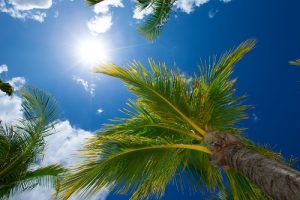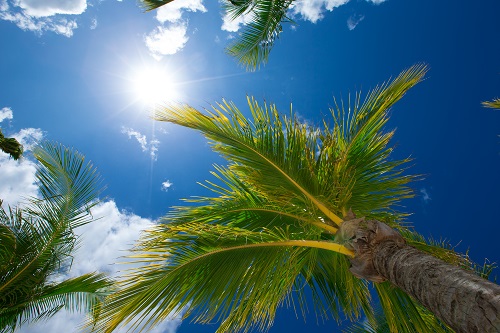
North Texas Palm Trees
If you would like to add a Mediterranean look to your landscape, you might consider buying palm trees. We mostly associate palm trees with Florida, coastal California and the tropics. None of those places has to confront the infrequent severe cold spells of north Texas. However, if you would like to add a touch of the tropics to your yard, you do have some choices that are proven to survive, if not thrive in the MetroPlex.
The right palms around a pool can soften a pool hardscape and add a more inviting topical look to the area. In general, there are two types of palms. There are the ones with fan-shaped leaves (fronds) and ones with feather-like leaves (fronds). The leading cause of death for DFW palm trees is freezing temperatures. They are tolerant of most soils and even though they can develop issues with insects and diseases, cold is their number one limiting factor.
Windmill Palm, Trachycarpus fortunei – One of the hardiest palm trees in the DFW area of North Texas, they can grow in excess of 30 feet, and can withstand temps to about 10 degrees. Thanks to its fuzzy, fibrous trunk, It rarely needs added winter wrapping or covering. Ideal accent for around a pool, but will grow better with some partial shade.
Mediterranean Fan Palm, Chamaerops humilis – If you are looking for a shorter, but still hardy palm tree, the Mediterranean Fan Palm is a great choice. This multi-trunked palm usually maxes out at about 10 feet tall and 6-8 feet wide, it will thrive in the ground or in a container.
Pindo Palm, Butia capitata – While not on the same hardiness scale as some palm trees, the unique Pindo palm features impressive blue-green arching 10 foot long leaves that curve toward the ground. Additionally, in mild climates, the Pindo Palm produce an edible fruit that can be used to make preserves or jelly.
Texas Sabal Palm, Sabal texana – Sabal palms are the only native Texas palm tree. They easily adapt to a variety of soils and growing conditions, and while a bit less hardy than many other palm species, they tolerate most tough North Texas winters. The sabal trunk features a striking pattern of “boots” where the lower leaves grow from the trunk. They frequently stay on for years and give the Sabal palm a unique look versus the other palms.
Mexican Fan Palm, Washingtonia robusta – While the Mexican Fan Palm fares poorly in hardiness, it can do fine for years but will need some covering during ice storms or it will suffer a lot of damage, and may even die. On the good side, this upright palm grows quickly, is drought-tolerant, and its leaf stems have an attractive hooked pattern.
DFW Palm Trees – Summary
As you’ve seen, there’s more to these unique plants than beauty. Many require more care in winter than others, and that should be a major consideration when considering adding a palm tree to your landscape. Be sure to check the hardiness rating of any palms you buy. Just because the palms are being sold in the DFW area, it doesn’t mean that they will work for you and your situation. There are several good nurseries in the DFW area that sell palms. They can be purchased as small as 1-gallon size to very large palms several feet tall that would need to be installed with a crane.
